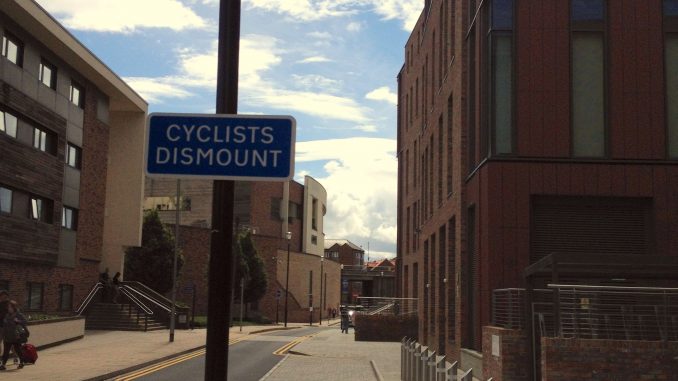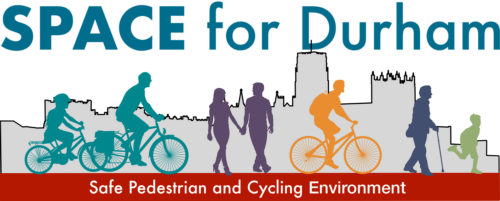
Four years ago Mark Treasure wrote a detailed posting on his blog asking why no-one cycles in Durham. Mark, a seasoned campaigner for better cycling infrastructure, cast his expert eye over our city and, with only a couple of days’ observation, spotted pretty well everything about our city’s cycling provision that is inadequate, absurd and downright dangerous. His conclusions were damning: “I don’t think it would be unreasonable to describe Durham as institutionally anti-cycling. I doubt the city has consciously drawn up plans to design out the use of bikes, but – unconsciously or otherwise – it seems every effort has been taken to ignore cycling, or to make it as unpleasant or as inconvenient as possible. The statistics bear out the results.”
So, four years on, have matters improved? Trust Pathways would suggest that, apart from a handful of small but welcome developments, they have not. In one or two places, they may even have got worse; and we must conclude that, despite Mark’s blog being widely distributed and despite other, professional, studies commissioned by Durham County Council making similar suggestions for promoting cycling, the Highways Department is still trying to keep bicycles out of Durham.
Let’s look at some of Mark’s observations and see how matters stand today. First to grab his attention was the main through-road, the A690, between Framwellgate Peth and the Leazes Bowl roundabouts. His verdict was, “…dire… It’s impossible to imagine ordinary people choosing to ride on these kinds of roads, mixing with motor traffic”.
Leazes Bowl, and Gilesgate roundabout further east, have since been completely rebuilt. This presented an excellent opportunity to give over more space to cycling and walking. The Council’s argument for this work was that it had to improve traffic flow to reduce pollution levels. The possibility that this could be done by reducing traffic levels was not entertained. However, the redesign did result in one or two improvements for people attempting to cross the city by bike.


A new wider pavement was put in at Leazes Bowl and labelled as a “shared use” path, which is fine as far as it goes; although, in general, busy pavements in city centres are not recommended for dual-use in the best design practice manuals. However, this cycle path is still not continuous to Gilesgate roundabout and people wishing to access New Elvet by bike have to use the convoluted underpass route. During the consultation, council officers suggested that the pavement on New Elvet Bridge would also be converted to shared pedestrian/cycle use, but almost a year after the completion of the roundabout rebuild there is no sign of additional cycle links being designated.

Gilesgate roundabout itself was redesigned with light-controlled crossings. These are a considerable improvement in safety over what went before, though that’s not saying much; and in terms of convenience it involves being herded into cages like cattle and held waiting for up to two minutes for a five second green-light to reach the central island. At a late stage in the design, some suggestions made via the Durham City Cycle Forum were incorporated, but the project did not tackle issues of joining and leaving the shared-use routes fully, so the result is unsatisfactory in various ways.

At the Framwellgate end, nothing has changed. In fact, matters have deteriorated as the demolition of the Gates shopping centre has closed one path over Millburngate Bridge. Durham County Council has declared the remaining footway “dual use”, which at least allows cyclists to cross the bridge away from the traffic, but it’s hardly ideal since the closures have forced all pedestrians and cyclists onto the one path.


Who thinks this is an adequate cycle path? A council which wanted to annoy both cyclists and pedestrians could hardly do a better job.
Another bridge which was closed to cycles at the time of the blog’s publication was Prebends’. This has since been adopted for cycling, ending a notorious detour for people trying to get from the peninsula to the University and other southerly parts of the city. Other restrictions, which Mark was at a loss to explain, remain in place. These include Silver Street and Old Elvet bridge. “While some of these locations are probably too busy with pedestrians for cycling to be allowed at peak times, it might at least be worth a trial,” he suggested, as did JMP, the consultants who drew up the Durham City Sustainable Transport Strategy. As of yet, nothing has happened.
Possibly the most grievous of Durham’s anti-cycling sins that have been committed after the publication of “Why don’t People Cycle in Durham”, concerns the National Cycle Network Route 14 which passes through the city centre. “To call it ‘indirect’ would be generous”, said Mark. He paid particular attention to the way in which the route “absurdly” sends cyclists the wrong way up a one-way street, with no exemptions for cycling. The section he refers to is at Freeman’s Reach. In his photograph, taken opposite the Premier Inn, the old ice rink is still in evidence. After that, the whole riverside stretch of this road was cleared for redevelopment and is now the site of the new Passport Office.
A perfect time, one would think, for Highway officers to start with a clean sheet and design and install a road scheme that would actually allow people to cycle along the National Cycle Network (an outlandish idea, we recognise). So, what happened?

Yes, that’s right – everything that was wrong with the old road scheme was built back into the new one. What a completely wasted opportunity. Who, but someone with an anti-cycling agenda would propose this? Who signed it off?
The County Council’s Cycling Strategy, 2012–15, has now expired and a new strategy is in the course of preparation. It is questionable how useful worthy strategies are, when the day-to-day business of the Highways Authority seems to be so little affected by the aspirations expressed. The new strategy should focus on developing complete coherent routes covering the last mile to key destinations like the city centre, and on building infrastructure which is of a high enough quality to allow people of all ages and abilities to be confident to use it. But it will also need implementing, which means adequate staff resource, training the highways engineers in modern cycle design standards, and ensuring that cycling needs and opportunities are identified at the outset of any major work programmes. Otherwise, given the glacial pace of change so far, we will be no further forward in another four years.

Leave a Reply